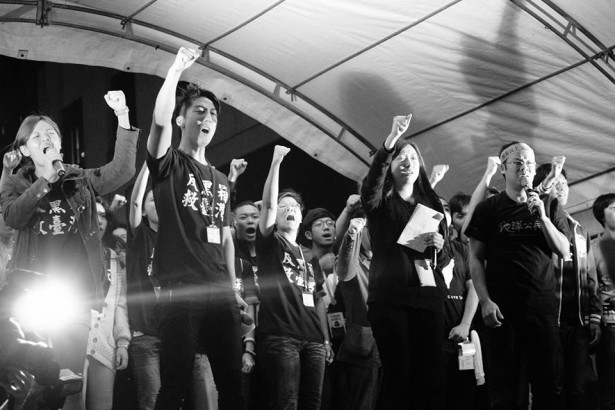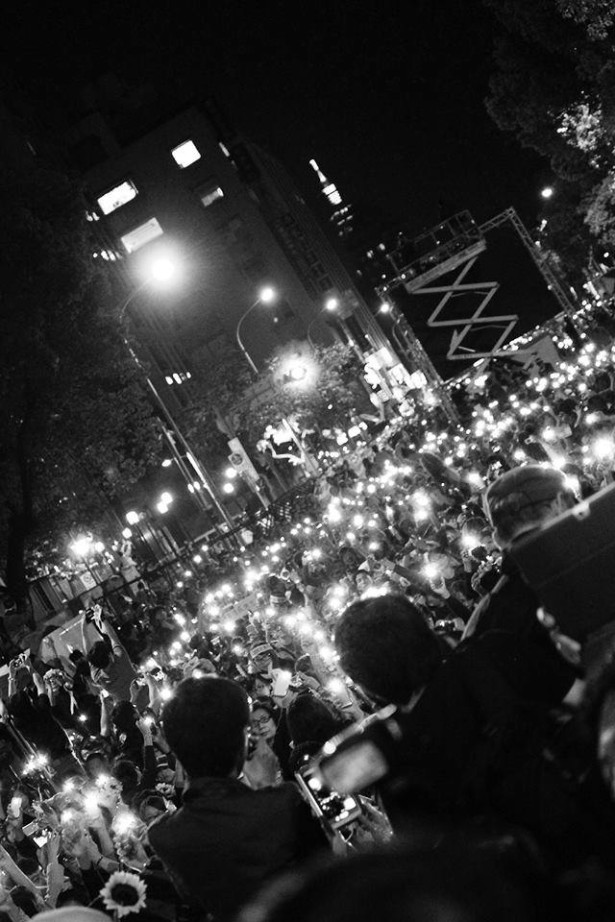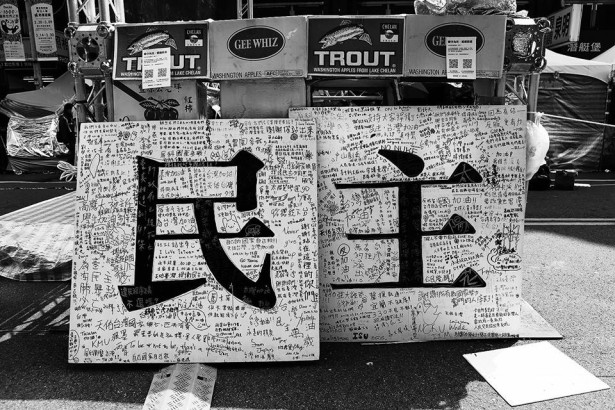
At 6:07 a.m. on April 10, the students inside the Taiwanese parliament voluntarily left the assembly hall while 20,000 people outside showed their support and witnessed the end of the occupation.
The students passed sunflowers one by one from the parliament to the crowd to symbolize planting the seeds of democracy in Taiwanese society. This action was followed by a series of lectures and the crowd sang, once again, the Sunflower Movement protest song “Island’s Sunrise” together.
Since April 7, when the students announced the end of their protest, the students gradually began to clean up the parliament. They took down the banners on the facade of the parliament, placed the room chair in correct order and cleaned most of the rooms.
It was a calm ending to an occupation that had extended for almost a month — a standoff between the Sunflower Movement student protesters and President Ma Ying Jeou’s government.
It’s a decision that didn’t come lightly, as many protesters debated the correct action for the movement.
“The students understood that it was time for their forces to retreat and end their occupation of the Legislative Yuan [Taiwan’s parliament],” said R. Griffin Lee, an editor for the Taiwan Voice, a Facebook-led group of volunteers that focuses on translating and spreading news from Taiwan in English. “If they dragged it out any longer, they would lose the majority support they were getting generally. They are hesitantly putting the ball in Ma’s court.”
On March 31, Taiwan saw the biggest demonstrations in the history of its young democracy.
Half a million people marched in Taipei to protest an unpopular trade pact with China and contested President’s Ma policies of creating close political and economic ties with China. The protesters gathered in front of the presidential building, where one day before Ma had refused to halt the controversial economic pact that would open Taiwan’s service industry to Chinese investors.
Public turnout was high and security was tight, as 3,500 police were deployed in the official presidential neighborhood, which was barricaded by barbed wire.
There were fears of another clash between riot police and protesters similar to what happened after protesters tried to forcefully occupy the executive building of Taiwan’s government on March 23, which led to almost 200 people being injured.

Protest leaders declared it as the high point of the movement, which began on March 18. On that day a group of 200 students stormed the Taiwanese Parliament and occupied the assembly hall, vowing not to leave until the trade deal was reviewed item by item.
Taiwanese protesters were opposed to what they saw as an unacceptable abuse of power by President Ma and the ruling Kuomintang party in forcing an economic treaty that wasn’t properly reviewed.
They demanded new legislation regulating any further deals with China — a proposal that President Ma at first seemed to agree to, but he later maintained his position that the current trade pact wouldn’t be stopped.
Over the next three weeks, the situation descended into a stalemate between President Ma’s government and the student movement, led by Lin Fei Fan, a political science student, in southern Taiwan.
Both sides hardened their position, making great effort to gather support and tighten their ranks.
Progress seemed to be made when, on March 31, the Executive Yuan was expected to create the draft of a bill overseeing cross-strait deals that the students were demanding. However, further discussions between two most influential political parties on how to handle the service trade pact failed.
On April 6, Minister of Legislation Wang Jin-Pyng went into the legislative chambers, shook protesters’ hands and showed concern for their well-being. He pledged not to preside over further parliamentary debate about the pact until a law has been introduced to monitor such agreements with China.
Regarding the damages in the assembly hall Wang stated: “Don’t worry, I will handle it.”
This was seen as a victory for the protesters as well as Wang, who has maintained a very popular image with Taiwanese public opinion. As he attempted to serve as moderator between the different sides, his conflicts with President Ma once again came to the fore.
“One of the greatest accomplishments of the student protesters was to inspire young minds — too long stifled or ignored by Taiwanese society — to take an active role in shaping their futures,” said Andrew Bliss also from the Taiwan Voice.
“People are now more aware of the seriousness of this matter,” said Lee. “The disappointment and mistrust towards the government are much more pronounced these days.”
While President Ma seeks to see the trade pact through, the student protesters have fought to maintain the momentum achieved with the mass protests. They are now looking to avoid a shift in public attention and assess the success of the Sunflower Movement.
Many forms of media — social media, online live streams and radio shows — have been used by the protesters to bolster the movement’s momentum.
In the last week of the occupation, an alternative online radio was organized by Indi Dadi, a known cultural promoter, in front of the Legislative Yuan. With an internet live stream, the radio show allowed protesters to voice their opinion on the situation from late evening until 6 a.m. The guests would range from anyone passing by to the student leaders. Shows always began with the guest swearing against the government, while a large crowd of protesters and police laughed accordingly.

The movement also used crowd-funding to support their initiatives. On March 30, the international edition of the New York Times included a full-page ad explaining the reasons for student protests. Entitled “Democracy at 4 a.m.,” the ad was paid for by donations from 3,500 Taiwanese citizens, through Flying V, a crowd-funding website that managed to raise almost $200,000 dollars in only three hours. Other half-page ads were placed in the Chinese-language papers Apple Daily and Liberty Times.
Some people, however, see the government’s own reactions as the most important factor in keeping the Taiwanese people’s attention on the movement.
CNN reported that Flying V was fined $1,700 for “contract violations” by the Taiwanese online supervising authorities and told to refuse any further proposals related to the Sunflower Movement, which would be subject to government inquiry.
“Ironically, the responses — and at times, non-response — from the Ma administration led to the public becoming more frustrated with the government,” said Lee. “And the police crackdown on March 24 simply added fuel to the fire of anger among the citizens of Taiwan.”
The Minister of Justice Luo Ying-shay, for example, claimed that the government was considering bringing criminal charges against the student protesters. They could face sentences of up to seven years, he said, for damaging public utilities even if people volunteered to repair them.
The cost of the occupation itself has also been highly debated.
A high-ranking Legislative Yuan official said, that it will cost more than $3 million and one month of work to repair damage done to the legislature’s main chamber, while student representatives — with the help of volunteer lawyers and teachers — assessed that nine microphones, two amplifiers, several windows and chairs, and one wall were damaged.
There are many doubts about what will happen to the movement now that the occupation has ended.
“It’s hard to say,” said Bliss. “It will definitely shrink since people will go back to their normal lives and take care of their own personal affairs.”
“In the future, it all depends on how they organize and frame their own identity,” he continued. “Do they want to act as a dissenting voice to the government in the form of social movements, or do they want to participate and join the system as a third party and run for elections?”
The recent protests have been defined by Taiwanese media in a variety of ways. They were a clash between a politically apathetic older generation, still haunted by 43 years of martial law, and a politically conscious and active younger generation. Alternatively, they represented a conflict between people for and against China, or a political battle between the island’s major political parties.
Many parallels were also made with the student protests in 1990 that finished the period of martial law known as “White Terror.”
“If you look at the student-led Wild Lily Movement 25 years ago, as well as Cheng Nan-Jung, who immolated himself advocating press freedom, all of these past examples left a mark on Taiwan’s history,” said Sophie Hsu, another protest volunteer editor at Taiwan Voice.
“I am sure that the stories from what happened in the Sunflower Movement will also endure,” Hsu continued, “given that the entire process was recorded with live feeds, as well as in media reports, and even in the official documents produced by the Sunflower Movement through Facebook.”
Now as legislators return to the assembly hall to resume their functions, the Taiwanese public opinion eagerly awaits for their elected officials to overcome their political rivalry and use their powers to achieve progress in creating legislation to review any future cross-strait agreement.
The protest has transformed into a long-term political movement developing in different directions. Sunflower Movement activists have launched the “Appendectomy Project,” which aims to dismiss inappropriate legislators who fail to deliver the voice of people, and are traveling from town to town to talk about the pros and cons of the trade agreement with China and clarify the protesters main concerns. And even though the physical occupation has ended, Lin Fei-fan declared that the people will still pay attention to the Ma government’s future decisions.
“I think the voice of Taiwanese people has been conveyed very clearly to the government,” said Huang Yu-fan, a member of the student-led political organization Young Generation Guarding Taiwan Democracy. “Minister of Legislative Yuan Wang Jing-ping showed a positive response and so did the protesters as we withdrew from the Parliament. But if the government fails to keep their promise, we will go back to protest again. This time it will be the presidential building.”
